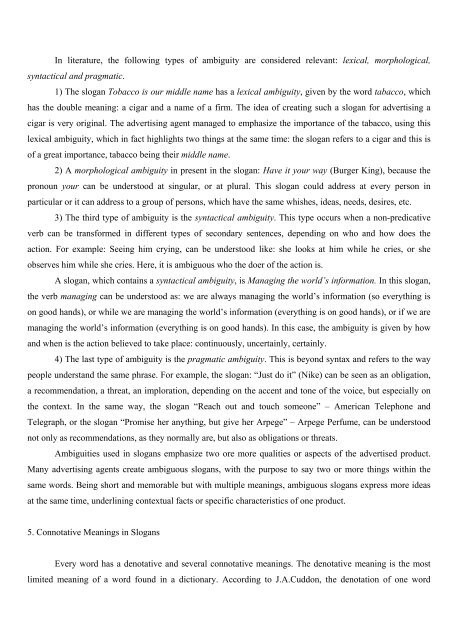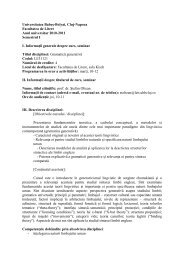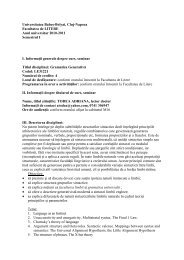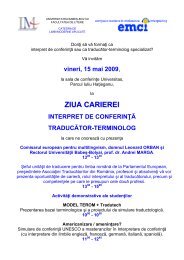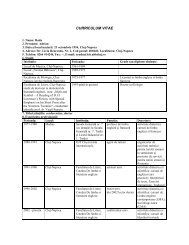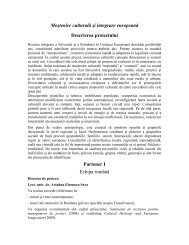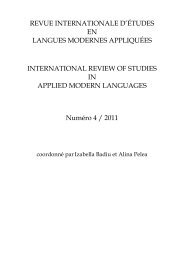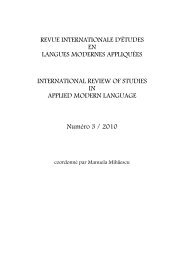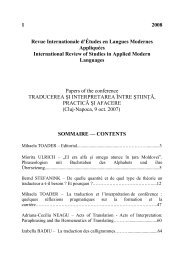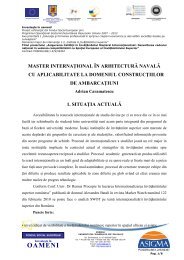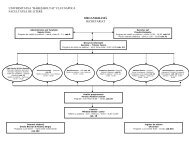Dimensiuni ale limbajului n context carceral
Dimensiuni ale limbajului n context carceral
Dimensiuni ale limbajului n context carceral
Create successful ePaper yourself
Turn your PDF publications into a flip-book with our unique Google optimized e-Paper software.
In literature, the following types of ambiguity are considered relevant: lexical, morphological,<br />
syntactical and pragmatic.<br />
1) The slogan Tobacco is our middle name has a lexical ambiguity, given by the word tabacco, which<br />
has the double meaning: a cigar and a name of a firm. The idea of creating such a slogan for advertising a<br />
cigar is very original. The advertising agent managed to emphasize the importance of the tabacco, using this<br />
lexical ambiguity, which in fact highlights two things at the same time: the slogan refers to a cigar and this is<br />
of a great importance, tabacco being their middle name.<br />
2) A morphological ambiguity in present in the slogan: Have it your way (Burger King), because the<br />
pronoun your can be understood at singular, or at plural. This slogan could address at every person in<br />
particular or it can address to a group of persons, which have the same whishes, ideas, needs, desires, etc.<br />
3) The third type of ambiguity is the syntactical ambiguity. This type occurs when a non-predicative<br />
verb can be transformed in different types of secondary sentences, depending on who and how does the<br />
action. For example: Seeing him crying, can be understood like: she looks at him while he cries, or she<br />
observes him while she cries. Here, it is ambiguous who the doer of the action is.<br />
A slogan, which contains a syntactical ambiguity, is Managing the world’s information. In this slogan,<br />
the verb managing can be understood as: we are always managing the world’s information (so everything is<br />
on good hands), or while we are managing the world’s information (everything is on good hands), or if we are<br />
managing the world’s information (everything is on good hands). In this case, the ambiguity is given by how<br />
and when is the action believed to take place: continuously, uncertainly, certainly.<br />
4) The last type of ambiguity is the pragmatic ambiguity. This is beyond syntax and refers to the way<br />
people understand the same phrase. For example, the slogan: “Just do it” (Nike) can be seen as an obligation,<br />
a recommendation, a threat, an imploration, depending on the accent and tone of the voice, but especially on<br />
the <strong>context</strong>. In the same way, the slogan “Reach out and touch someone” – American Telephone and<br />
Telegraph, or the slogan “Promise her anything, but give her Arpege” – Arpege Perfume, can be understood<br />
not only as recommendations, as they normally are, but also as obligations or threats.<br />
Ambiguities used in slogans emphasize two ore more qualities or aspects of the advertised product.<br />
Many advertising agents create ambiguous slogans, with the purpose to say two or more things within the<br />
same words. Being short and memorable but with multiple meanings, ambiguous slogans express more ideas<br />
at the same time, underlining <strong>context</strong>ual facts or specific characteristics of one product.<br />
5. Connotative Meanings in Slogans<br />
Every word has a denotative and several connotative meanings. The denotative meaning is the most<br />
limited meaning of a word found in a dictionary. According to J.A.Cuddon, the denotation of one word


